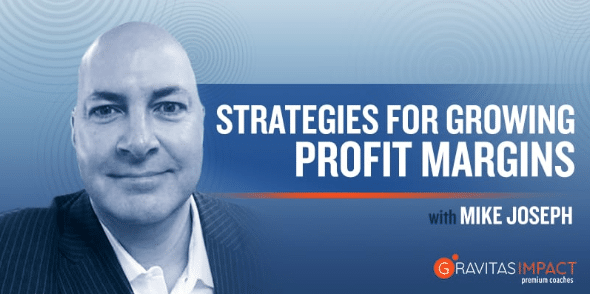
What obstacles are keeping businesses from increasing their profit margins and how can they get around them? We recently discussed this question with Mike Joseph, senior advisor for Osborne Interim Management and one of ourGravitas Impact premium coaches. Read on to see what he had to say!
Where Businesses Get Stuck
Since the internet boom of the ‘90s, the market has undergone a rapid transformation that has changed the way consumers find and purchase products. While this has resulted in a better, more efficient experience for the customer, it has created new obstacles for businesses and their profit margins.
“Technology is a big obstacle to growing profit margins,” Joseph said. “Customers have access to competitive pricing instantly through the internet. They can quickly educate themselves and demand better prices for products and services like never before. Inevitably, this is going to put downward pressure on prices.”
That said, it’s not just pricing that gives technology an edge – time and convenience play a role as well. In a 2017 article about the decline of retail, The Economist wrote, “E-commerce’s most obvious edge is in selection and convenience. Even the biggest store cannot hold as many items as Amazon can offer. Walmart conquered America by saving consumers money; Amazon is doing the same by saving them time.”
Of course, as Joseph pointed out, technology isn’t the only thing limiting businesses today.
“There are a handful of other factors preventing a company from growing and increasing profits,” he said. “These include: competition, currency exchange, product lifecycle, costs of goods sold (COGS), and the brand itself.”
Strategies for Growth
While situations may vary from business to business, Joseph outlined a few key areas where companies can and should lend their attention. He first encourages businesses to put a laser focus on COGS to ensure that no products are unnecessarily wasted, spoiled, or lost. He also suggests prioritizing high margin products over low margin products.
“As my background is in hospitality,” he said, “one of the strategies that I employ for this type of customer is adjusting the sales mix. For example, if my client can sell more alcoholic beverages (high margin) rather than food (low margin), overall profit margins will be far greater.”From there, however, Joseph navigates into broader, more brand-focused strategies.
“Ensure demand for your product or service is high due to its unique offering. If few in the market can do what you do, margins can remain strong and even increase.”
Speaking further on the unique offering Joseph drills down on how this strategy can help businesses grow their profit margins, even if someone else offers a cheaper price.
“Very few business owners feel comfortable raising their prices when sales soften or the economy slows down,” he said, “but if you have confidence in your unique offering, revisiting your pricing strategy can actually be a prudent move. You just have to give your customers a reason to buy from you with little reason to explore alternative options. As long as your value proposition is signicant, pricing sensitivity is far less of an issue. Case in point: on a recent trip to the mall, I saw many storefronts that were slow or closed, but the Apple store had people lined up to get in!”
(It’s worth noting that Apple reported billions in gains in Q4 of 2018)As a final piece of advice, Joseph encourages business leaders to keep an eye on a handful of market forces that could have an impact on profit margins in2019.“The trade war with China may continue to drive up the cost of raw materials and manufacturing products,” Joseph said. “Currency flections, as well as investor confidence (or lack thereof) will also play a role.”
